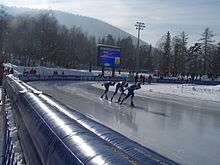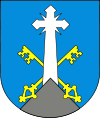Zakopane
| Zakopane | ||
|---|---|---|
|
Zakopane at night | ||
| ||
 Zakopane | ||
| Coordinates: 49°18′N 19°57′E / 49.300°N 19.950°E | ||
| Country |
| |
| Voivodeship | Lesser Poland | |
| County | Tatra | |
| Gmina | Zakopane (urban gmina) | |
| Established | 17th century | |
| Town rights | 1933 | |
| Government | ||
| • Mayor | Leszek Dorula | |
| Area | ||
| • Total | 84 km2 (32 sq mi) | |
| Highest elevation | 1,126 m (3,694 ft) | |
| Lowest elevation | 750 m (2,460 ft) | |
| Population (2006) | ||
| • Total | 27,486 | |
| • Density | 330/km2 (850/sq mi) | |
| Time zone | CET (UTC+1) | |
| • Summer (DST) | CEST (UTC+2) | |
| Postal code | 34-500 to 34-504 | |
| Area code(s) | +48 18 | |
| Car plates | KTT | |
| Website |
www | |
Zakopane (pronounced [zakɔˈpanɛ]) is a town in the extreme south of Poland. It lies in the southern part of the Podhale region at the foot of the Tatra Mountains. From 1975 to 1998 it was in Nowy Sącz Province, but since 1999 it has been in Lesser Poland Province. It had a population of about 28,000 as of 2005. Zakopane is a center of Góral culture and is known informally as "the winter capital of Poland". It is a popular destination for mountaineering, skiing, and qualified tourism.
Zakopane is located in southernmost Poland near the border with Slovakia. It lies in a valley between the Tatra Mountains and Gubałówka Hill. It can be reached by train or by bus from district capital Kraków, which is about two hours away. Zakopane has an elevation of 800-1,000 meters above sea level. The town is centered at the junction of Krupówki and Kościuszko Streets.
History
The earliest documents mentioning Zakopane date to the 17th century, describing a glade called Zakopisko. In 1676 it was a village of 43 inhabitants. Zakopane became a center for the region's mining and metallurgy industries; in the 19th century, it was the largest center for metallurgy in Galicia. It expanded during the 19th century as the climate attracted more inhabitants. By 1889 it had developed from a small village into a climatic health resort of 3,000 inhabitants. Rail service to Zakopane began October 1, 1899.
The ski jump on Wielka Krokiew was opened in 1925. The cable car to Kasprowy Wierch was completed in 1936. The funicular connected Zakopane and the top of Gubałówka in 1938.
In March 1940, representatives of the Soviet NKVD and the Nazi Gestapo met for one week in Zakopane's Villa Tadeusz, to coordinate the pacification of resistance in Poland. Throughout World War II, Zakopane served as an underground staging point between Poland and Hungary.
From 1942 to 1943, 1,000 prisoners from the German Kraków-Płaszów concentration camp were set to work in a stone quarry.[1]
Architecture
The Zakopane Style of Architecture is an architectural mode inspired by the regional art of Poland’s highland region known as Podhale.[2] Drawing on the motifs and traditions in the buildings of the Carpathian Mountains, the style was pioneered by Stanislaw Witkiewicz and is now considered a core tradition of the Góral (Mountaineer) people.[3]
Sports
The High Tatras are a popular destination among hikers, skiers, ski-tourers and climbers.
Mountaineering
Many climbs begin at Morskie Oko, a lake at an elevation of 1,395 meters. From Morskie Oko climbers proceed to Czarny Staw, another lake, and thence up Rysy, whose northwestern peak is the highest point in Poland at 2,499 meters. A slightly shorter but more difficult climb is Mieguszowiecki Szczyt. Other popular climbs include Giewont, Mnich, and Cubryna. Most of the High Tatras are visible from these peaks on clear days.

In summer, lightning and snow are both potential hazards for climbers, and the weather can change quickly. Thunderstorms are common in the afternoons. In winter the snow can be up to several meters deep.
Skiing
In the winter, thousands arrive in Zakopane to ski, especially around Christmas and in February. The most popular spots are Kasprowy Wierch, Nosal and Gubałówka Hill.[4] There are a number of cross country skiing trails in the forests surrounding the town.
Zakopane hosted the Nordic World Ski Championships in 1929, 1939, and 1962; the winter Universiades in 1956, 1993, and 2001; the biathlon World Championship; several ski jumping world cups; and several Nordic combined, Nordic and Alpine European Cups. It hosted the Alpine World Ski Championships in 1939, the first outside the Alps and the last official world championships prior to World War II.
Zakopane made unsuccessful bids to host the 2006 Winter Olympics and the 2011 and 2013 Alpine World Ski Championships.
Tourism
Zakopane is visited by over 2,500,000 tourists a year. In the winter, tourists are drawn to Zakopane for its excellent conditions for winter sports: alpine skiing, cross-country skiing, snowboarding, and ski jumping. In the summer, tourists come to enjoy hiking, climbing, and spelunking. Many come to experience góral culture, which is rich in its unique styles of food, speech, architecture, music, and costume. Zakopane is especially popular during the winter holidays, which are celebrated in traditional style, with dances, decorated horse-pulled sleighs called kuligs and roast lamb.
A popular tourist activity is taking a stroll through the town's most popular street: Krupówki. It is lined with stores, restaurants, carnival rides, and performers. Here, you can buy unique Zakopane souvenirs, such as an oscypek or a ciupaga.
A scene in Andrzej Wajda's film Man of Marble (Człowiek z marmuru) was filmed in Zakopane, introducing the town to a worldwide audience.
The mountain scenes from the Bollywood film Fanaa were filmed around Zakopane.

International relations
Twin towns
Zakopane participates in town twinning to foster international links.
 Bansko, Bulgaria
Bansko, Bulgaria San Carlos de Bariloche (Argentina)
San Carlos de Bariloche (Argentina) Bavel (Netherlands)
Bavel (Netherlands) Polonezköy, Turkey
Polonezköy, Turkey Saint-Dié-des-Vosges (France)
Saint-Dié-des-Vosges (France) Sopot, Poland
Sopot, Poland
Notable structures


- Wielka Krokiew ski jumping ramp
- Zakopane-Gubałówka funicular
Notable residents
- Jan Bachleda-Curuś, Olympian
- Tytus Chałubiński, physician
- Olga Drahonowska-Małkowska, one of the founders of Scouting movement in Poland
- Liz Glazowski, playboy model
- Władysław Hasior, sculptor
- Mieczysław Karłowicz, composer, conductor, mountaineer and photographer of the Tatra Mountains
- Jan Kasprowicz, poet, playwright
- Kornel Makuszyński, children's writer
- Jan Marusarz, Olympian
- Stanisław Marusarz, Olympian
- Władysław Orkan, writer
- Karol Szymanowski, composer; his house in Zakopane, the Villa Atma, is now a museum dedicated to him
- Stanisław Witkiewicz, painter and architect
- Stanisław Ignacy Witkiewicz (Witkacy), playwright, novelist, philosopher, photographer and painter
- Mariusz Zaruski, general, mountaineer and yachtsman
- Jerzy Żuławski, poet, writer
Notable visitors
- Joseph Conrad[5]
- Marie Curie[6]
- Bronisława Dłuska, Maria Skłodowska-Curie's physician sister, for whom Skłodowska-Curie established the Radium Institute—now the Curie Institute—in Warsaw.[7]
- Józef Piłsudski[5]
- Bolesław Prus[8]
- Artur Rubinstein[5]
- Edward Rydz-Śmigły, who painted some Zakopane sights
- Krystyna Skarbek[9]
- Rudolf Weigl[10]
- Aniela Zagórska, Joseph Conrad's niece and English-to-Polish translator.[11]
- Stefan Żeromski[12]
- Prince Charles
Gallery
 Koliba villa
Koliba villa Koliba villa
Koliba villa Koliba villa
Koliba villa- Interior of Koliba
 Jaszczurówka Chapel
Jaszczurówka Chapel- Pod Jedlami villa
- Szymanowski Museum at the Villa Atma
- Zakopane - view from Gubałówka Hill (Tatra mountains in the background)
- Zakopane - Gubałówka Hill ski run
- Zakopane - Gubałówka Hill: a nursery ski run
- Zakopane - Gubałówka Hill funicular entrance
- Krupówki
- Church of the Holy Family
- Helena Marusarzówna's grave in Peksów Brzyzek cemetery
- Katyń Memorial in Peksów Brzyzek Cemetery
- Local market
- Traditional wooden shrine
- Villa Konstantynówka, lodging of Polish-English author Joseph Conrad at outbreak of World War I, in 1914
Notes
- ↑ "Zakopane". sztetl.org.pl.
- ↑ "Zakopane Style Museum Zakopane | Poland". Zakopane Life. Retrieved 2011-06-03.
- ↑ "The Tatra Museum - The Museum of the Zakopane Style". Muzeumtatrzanskie.com.pl. Retrieved 2011-06-03.
- ↑ Seattle Times - Scenic Zakopane
- 1 2 3 Zdzisław Najder, Joseph Conrad: A Life, translated by Halina Najder, Rochester, New York, Camden House, 2007, ISBN 1-57113-347-X, pp. 458–63.
- ↑
- ↑ Zdzisław Najder, Joseph Conrad: A Life, translated by Halina Najder, Rochester, New York, Camden House, 2007, ISBN 1-57113-347-X, pp. 463–64.
- ↑ Krystyna Tokarzówna and Stanisław Fita, Bolesław Prus, 1847–1912: Kalendarz życia i twórczości (Bolesław Prus, 1847–1912: A Calendar of His Life and Work), edited by Zygmunt Szweykowski, Warsaw, Państwowy Instytut Wydawniczy, 1969, pp. 232, 235, et passim.
- ↑ Madeleine Masson, Christine: A Search for Christine Granville, G.M., O.B.E., Croix de Guerre, with a Foreword by Francis Cammaerts, D.S.O., Légion d'Honneur, Croix de Guerre, U.S. Medal of Freedom, London, Hamish Hamilton, 1975, p. 24.
- ↑ Waclaw Szybalski, "The genius of Rudolf Stefan Weigl (1883 – 1957), a Lvovian microbe hunter and breeder": in memoriam, McArdle Laboratory for Cancer Research, University of Wisconsin, Madison, WI 53705, USA.
- ↑ Zdzisław Najder, Joseph Conrad: A Life, translated by Halina Najder, Rochester, New York, Camden House, 2007, ISBN 1-57113-347-X, p. 463.
- ↑ Zdzisław Najder, Joseph Conrad: A Life, translated by Halina Najder, Rochester, New York, Camden House, 2007, ISBN 1-57113-347-X, pp. 463–64.
Bibliography
- Stanisław Kasztelowicz and Stanisław Eile, Stefan Żeromski: kalendarz życia i twórczości (Stefan Żeromski: A Calendar of His Life and Work), Kraków, Wydawnictwo Literackie, 1961.
- Zdzisław Najder, Joseph Conrad: A Life, translated by Halina Najder, Rochester, New York, Camden House, 2007, ISBN 1-57113-347-X.
- Krystyna Tokarzówna and Stanisław Fita, Bolesław Prus, 1847–1912: Kalendarz życia i twórczości (Bolesław Prus, 1847–1912: A Calendar of His Life and Work), edited by Zygmunt Szweykowski, Warsaw, Państwowy Instytut Wydawniczy, 1969.
External links
| Wikivoyage has a travel guide for Zakopane. |
| Wikimedia Commons has media related to Zakopane. |
- Official website
- Zakopane
- Jewish Community in Zakopane on Virtual Shtetl
- General information
- An English guide to Zakopane
- Twin towns
Coordinates: 49°18′N 19°58′E / 49.300°N 19.967°E


